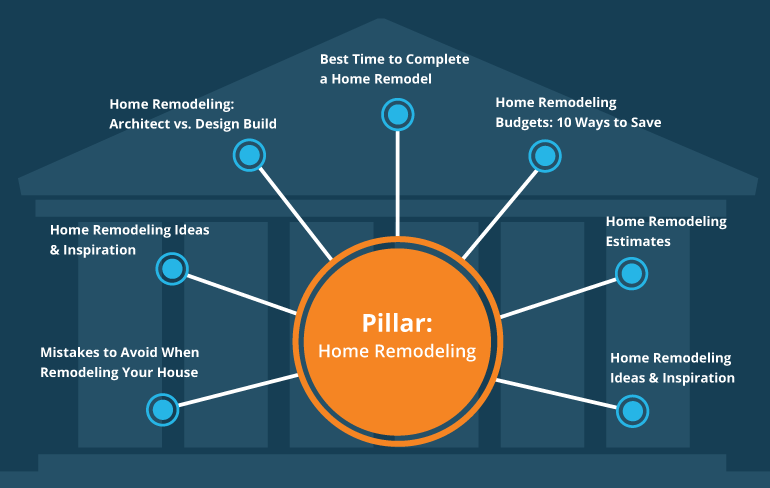How to Build Pillar Content and Topic Clusters for SEO

In the past, on-page SEO focused a lot on keyword optimization. Today, using the right keywords in your content is still essential. But digital marketers have been combining it with a more powerful SEO and content development strategy: pillar content pages and topic clusters.
What Is Pillar Content?
Neil Patel describes pillar content or pillar pages as “the topical cornerstone for a large portion of your site’s content.”
It is an umbrella post around a high-traffic keyword you wish to rank for. Because they briefly touch multiple subjects around your core topic, pillar pages are usually long. Depending on the subject, pillar content can have 2,000 words or more, answering the what, how, and why of your core topic as well as questions people often ask about the subject.
While pillar pages must be extensive, they do not go in-depth into each subtopic. Instead, pillar pages are hyperlinked to related articles that make up their topic cluster.
What Are Topic Clusters?
Topic clusters are made up of individual in-depth content that are all related to your broader pillar page or core topic.
Articles in these topic clusters usually target long-tail keywords that have lower search volume than the main keywords for your pillar pages. They go into detail on subtopics briefly discussed in the pillar content.
As illustrated above, websites can have multiple topic clusters, each with a pillar page. These topic cluster content link back to the pillar page and vice-versa.
How Pillar Pages and Topic Clusters Help Improve Your Search Rankings
While the concept of pillar and cluster content appears simple, it takes a lot of planning and research to reorganize and update your content and your website. If you have already published hundreds of articles, this task can even feel daunting.
So why invest time and energy shifting to this content strategy?
Because it benefits your target audience, your search rankings, and ultimately, your business.
Here’s how.
-
Helps search algorithms interpret what your site is about
Having comprehensive pillar pages with well-defined topic clusters or supporting articles makes it easier for search engines to determine what your site or web pages are about. This, then, can boost your chances of ranking better for your target topics.
-
Internal links between pillar pages and topic clusters help both search engines and your readers
Interlinking among your pillar pages and in-depth cluster articles help search engines discover and analyze your site’s content.
In an experiment, HubSpot also found that increasing internal links could boost both search rankings and impressions.
Moreover, internal links help your readers find the information they need and easily locate related posts on your site. Instead of leaving your site after reading your pillar post, the internal links lead them to other posts, encouraging them to stay longer.
And as they read more of your high-quality content, they will begin to trust your company while also discovering your products or services. They may even click on your calls to action–they may trust you enough to sign up for your newsletter and take the time to verify their email address to receive more of your content. As such, well-planned content can help move your site visitors down the sales funnel.
Five Essential Steps to Building Pillar Pages and Topic Clusters That Bump Up Your Search Rankings
Whether you’re building a new website or reorganizing hundreds of online content, here are some tips to help you nail down your pillar posts and topic clusters.
1st step: Identify Core Topics for Your Pillar Pages
Here are some questions you can use to identify core topics for your site.
- What are your target buyers’ core problems or pain points?
- What products, services, or solutions do you offer?
- What are your marketing goals?
- What topics do you want your site to rank for?
- What high-traffic keywords do you want to target, and what is the search intent behind these keywords?
- What topics are your competitors writing about?
- Is your core topic broad enough that you can break it down into several subtopics?
2nd step: List down subtopics for each pillar content
Once you have identified your core topics, make a list of subtopics and content ideas. After going through the questions above, you’ve undoubtedly generated a long list of relevant subtopics.
You can expand this list further by reviewing questions your customers or prospects often ask from your sales and marketing teams. You can check queries people post on online forums, the People Also Ask questions on Google search results, as well as the list of related searches at the bottom of search results pages.
3rd step: Do a content audit and identify gaps
Review your existing content and determine which ones already are or can be developed into pillar pages and classify the rest into topic clusters.
Next, go through the topics you’ve listed in previous steps and identify content gaps. Do you need to develop pillar pages for some topic clusters? Do you need new content for some subtopics or long-tail keywords in your list?
Aside from content gaps, look for content that you may need to revise or update to be relevant and more SEO and reader-friendly. For example:
- Does your pillar post have navigation menus that allow readers to quickly scan your content and jump to the sections they’re interested in?
- Do you need to optimize posts for your target keywords?
- Do your pillar pages or supporting content need fresh statistics?
- Are these growth hacking strategies or tips in your posts five years ago still effective today?
Keeping your content up-to-date assures your readers that you are reliable and on top of industry trends. This approach helps improve your business’ trustworthiness in the eyes of your target audience.
4th step: Implement internal linking strategies
As you develop your topic cluster content, include links to your pillar pages and vice-versa. Your interlinking strategy helps search engines understand which of your posts belong to the same clusters.
Use internal links to guide readers deeper into your site or to other pages they may be interested in, including your products, service pages, or other offers.
Aside from embedding links in your content, you can also put a related post or suggested reading section at the bottom of each page. This strategy makes it easier for your site visitors to discover internal content that are related to their search queries. Doing this keeps them on your site longer, instead of immediately closing their browsers or moving on to other search results.
Building internal links may seem simple at first. But as your content grows, you may find it hard to monitor which posts are already linked to your pillar pages as well as other posts in the same topic cluster.
So be sure to keep track of your content and internal links. HubSpot suggests keeping a sheet that lists the page URL, topic cluster, target keyword, the pages each content links out to, and other information.
5th step: Increase your backlinks
After producing high-quality pillar posts, your next step is to increase their discoverability and maximize their SEO potential. One way to do that is by working on your backlinking strategy.
Having backlinks from other websites, especially authoritative sites in your niche, can help enhance your search rankings. Having high-quality links pointing to your pages tells search engines that your website or content can be trusted.

Backlinks can also increase traffic to your site, as readers from these external pages are brought to your page when they click on the links.
Once visitors are on your pillar page, they may click on your internal links and discover other helpful content and offers you may have.
There are several ways to get more backlinks, such as by writing guest posts on leading publications in your industry and including a link to your pillar posts. You can also include content types in your pillar pages that generate more backlinks such as infographics and videos.
Conclusion
Organizing your content into pillar pages and topic clusters delivers several benefits for your business. Especially when combined with other SEO services and digital growth strategies, it can help you rank higher on search results. It gives you a system for identifying content opportunities and avoiding redundant posts that compete with each other on search results pages.
This content development strategy can also improve your bottom line by helping your ideal clients find you online. Added to that, it allows you to display your topical authority and win potential clients’ trust.
Do you have questions or tips for creating amazing pillar pages and brainstorming subjects for your topical cluster content? Share them below.
Author bio: Aaron Chichioco is the chief content officer (CCO) and one of the web designers of Design Doxa. Aside from his expertise on web/mobile design and development, he also has years of experience in digital marketing, branding, customer service, eCommerce and business management as well.

